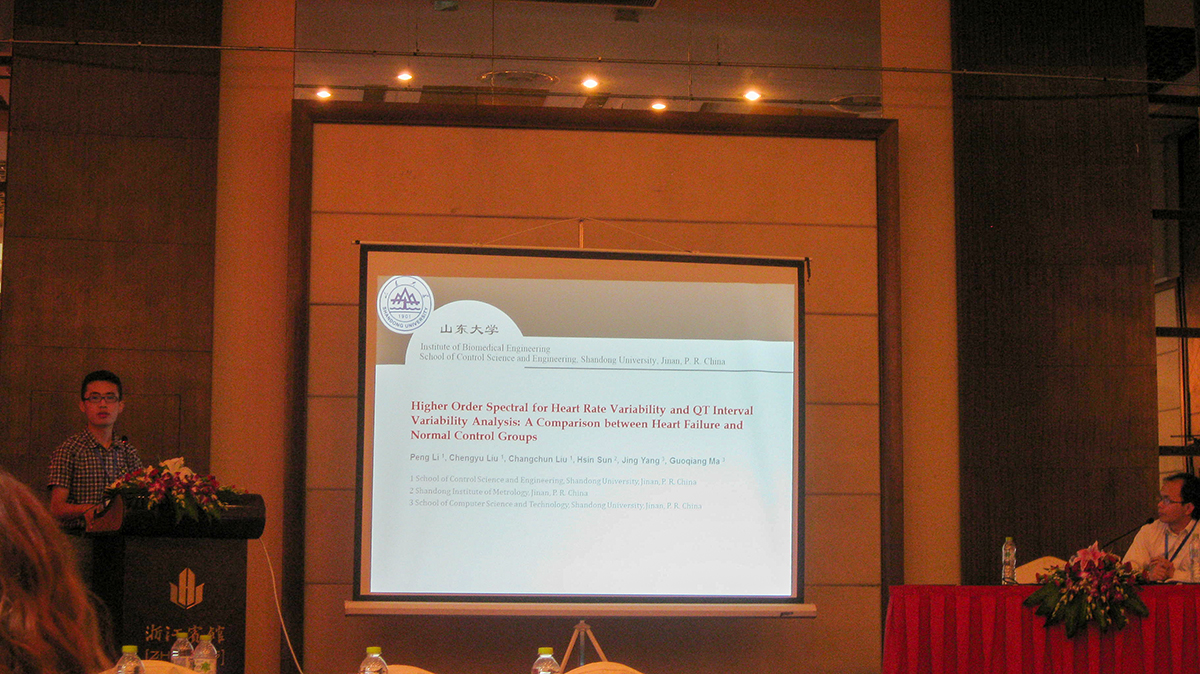About the PI: Presentations
Click the presentation title to fold or unfold the content.
Or click to Collapse/Expand All
- Date: July 30, 2024
- Event: Alzheimer's Association International Conference 2024
- Location: Philadelphia, PA
I was invited to present our recent work on delineating cognitive resilience using a digital biomarker extracted from actigraphy data during a Featured Research Session in AAIC this year. The work has been recently published in the journal Alzheimer’s & Dementia, which can be found here.

- Date: July 18, 2024
- Event: 46th Annual International Conference of the IEEE Engineering in Medicine and Biology Society
- Location: Orlando, FL
I organized a mini-symposium on the topic of digital biomarkers for brain health. This symposium is dedicated to delving into cutting-edge research within the realm of digital biomarkers, with a specific focus on signal analytics and feature engineering towards establishing meaningful biomarkers and exploring their transformative impacts on successful aging. The event served as a dynamic platform for researchers and clinicians to present their latest and most innovative findings, providing attendees with valuable insights into extracting meaningful health information from digital sources. I invited four experts to give talks during this symposium. Two of them are from the US, one from UK, and one from India. I gave an overview of the state-of-the-art for digital biomarkers research based on wearables.

- Date: May 30, 2024
- Event: American College of Sports Medicine 2024 Annual Meeting
- Location: Boston, MA
I presented our research on daytime napping and cognitive aging during our proposal symposium in ACSM 2024. The topic of this symposium is Timing is Everything: How the timing of behaviors impacts human health and aging biomarkers. Target audience of this session includes both clinicians and clinical translational researchers focused on treating and preventing cardiometabolic and neurocognitive diseases. I share recent findings related to the timing and (ir)regularity of daytime napping and relevance to adverse neurocognitive outcomes. The character that sit in my badge in the picture is Flat Stanley, a famous character from a well-known book series. My son was working on the Flat Stanley travel journal project in school this week, so I carried Flat Stanley to my talk.
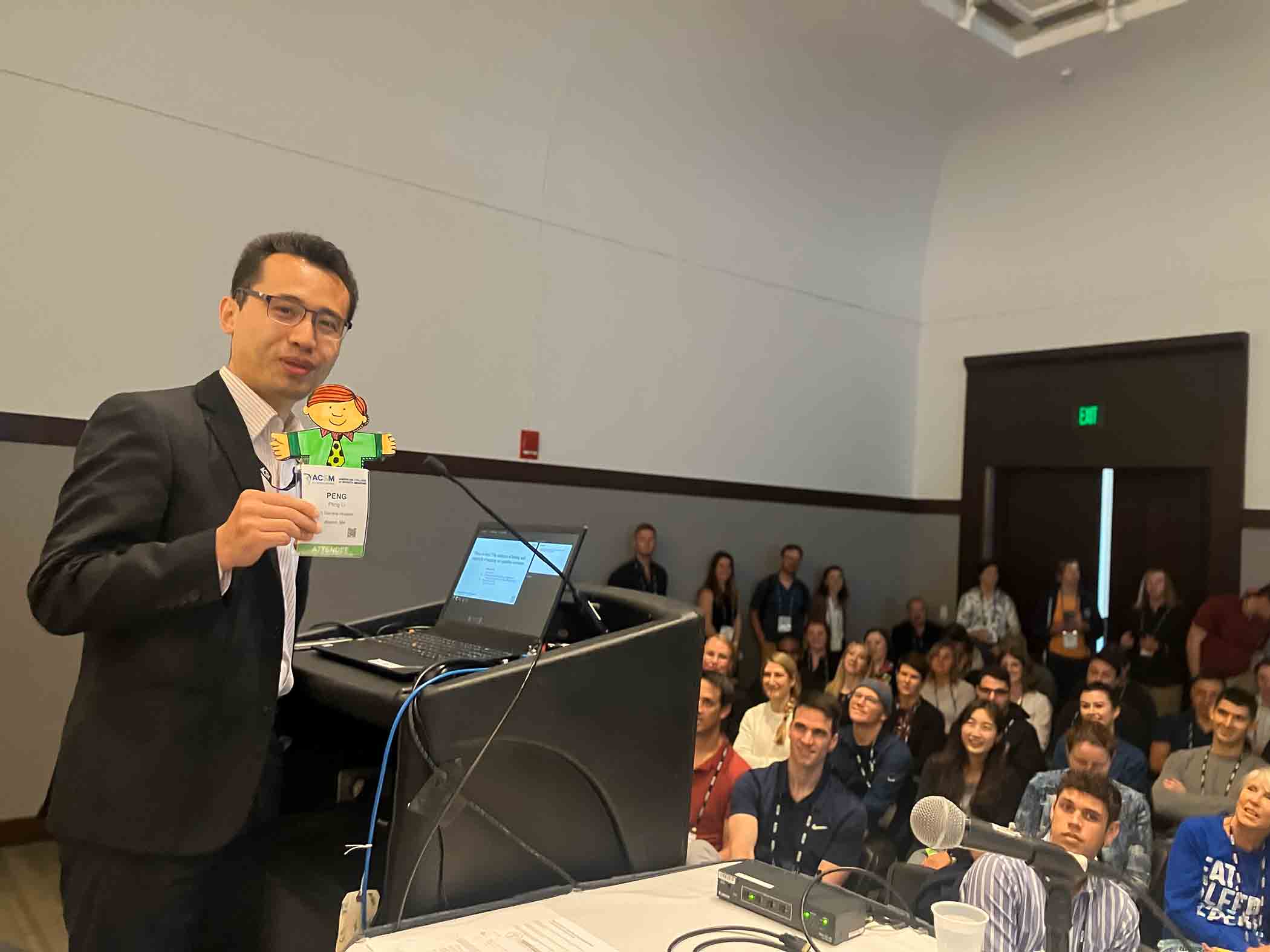
- Date: December 05, 2023
- Event: Public Lecture, National Science and Technology Council, Taiwan
- Location: Taoyuan City, Taiwan and online
I was invited to give this lecture that is available to the public. During this talk, I presented recent research on rest-activity rhythms and cognitive aging. More interestingly, I presented many new results obtained from a currently on-going project that links cardiovascular functional changes, including changes in autonomic function and arterial function, to dementia outcomes.

- Date: November 18, 2023
- Event: The 12th International Conference on Biomedical Engineering and Biotechnology (ICBEB 2023)
- Location: Macao, China and online
- Link:
I was invited to give a talk in the theme of biomedical signal processing and health outcomes. I will present both classical and new approaches in the field of chronobiology to analyze continuously monitored physiological signals for circadian rhythms or function. I will also present results from our translational studies in older as well as middle- to older-aged adults that provide novel insights into cognitive health and cognitive aging.

- Date: August 01, 2022
- Event: The Alzheimer's Association International Conference 2022
- Location: San Diego, CA
I am presenting our preliminary results on circadian age derived from multi-dimensional actigraphy features. This is an in-person event during the Alzheimer’s Association International Conference (AAIC) 2022.
- Date: July 29, 2022
- Event: The 24th International AIDS Conference
- Location: online and Montreal, Canada
- Poster: Download the poster
- Video: Watch the recorded presentation
I am presenting in AIDS 2022 virtually. The topic is on the randomness of motor activity, as described by a scaling exponent extracted from detrended fluctuation analysis. Please read our Sci Transl Med article for more information regarding the randomness of motor activity. This specific abstract shows that increased randomness in motor activity was associated with longer reaction time in people living with HIV infection but not in uninfected controls, implying a potential relation of circadian dysfunction with executive function. Click here to watch the recorded E-poster presentation!
- Date: June 08, 2022
- Event: SLEEP 2022
- Location: Charlotte, NC
This is an invited talk during the symposium session Disturbed Daily Activity Patterns and Alzheimer’s Disease: Latest Updates and Future Questions during the SLEEP 2022. I present our latest findings from prospective cohort studies of older adults, which were designed to examine how different actigraphy-derived measures including the sleep-wake cycle daytime napping, and daily activity fluctuations/rhythms predict the risk of developing Alzheimer’s dementia, and how these measures of daily activity patterns change with aging at different stages of AD (from normal cognition, mild cognitive impairment, to dementia). Hopefully upon completion of this presentation, the audience should be able to review multidimensional actigraphy features (MAF), their meanings and relevance to sleep/circadian regulation, advantages, and potential pitfalls, to recognize the potential of MAF in predicting future risk of Alzheimer’s dementia, and to recognize the longitudinal changes of MAF during cognitive aging.
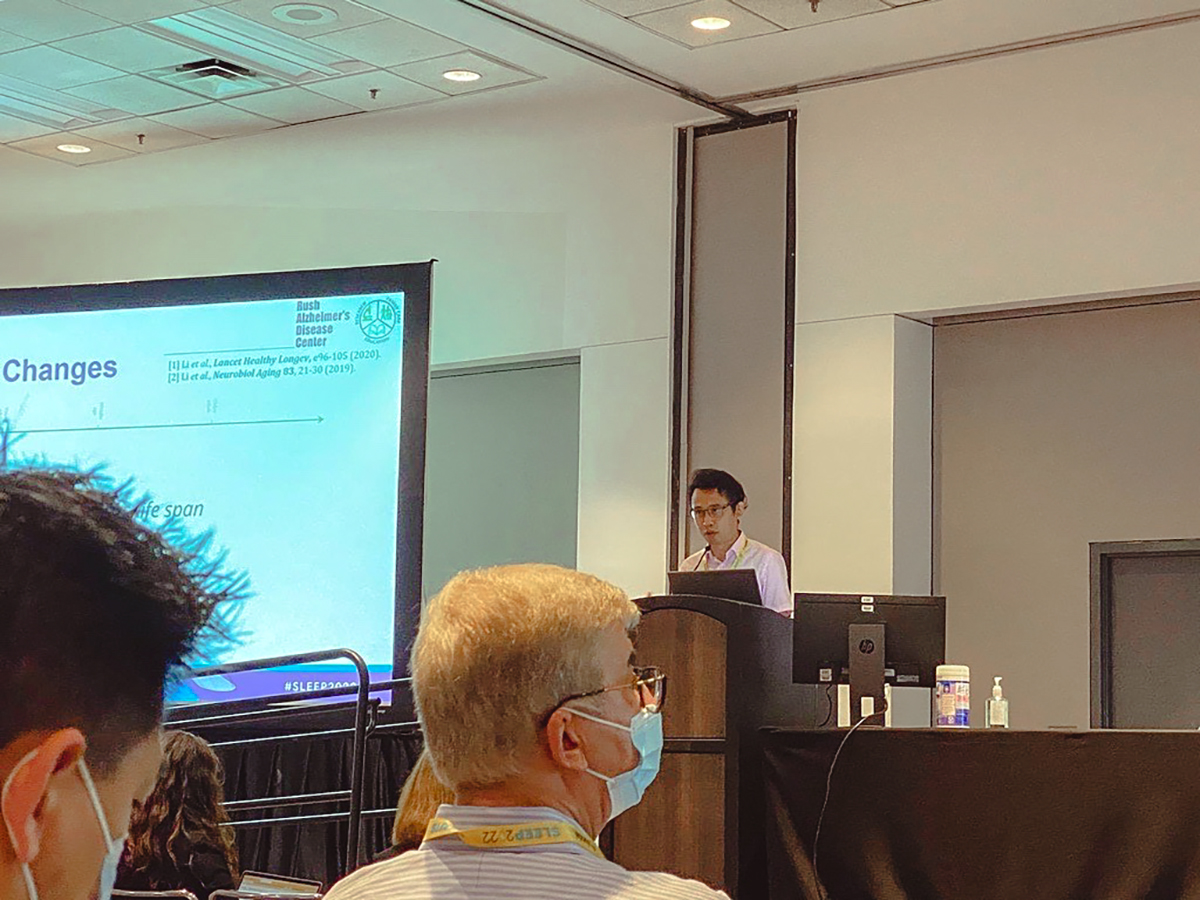
- Date: February 23, 2022
- Event: Departmental Seminar, Department of Psychology, The University of Hong Kong
- Location: online and Hong Kong, China
- Flyer: See details in the flyer
I was invited to give a talk on our recent research related to circadian rhythms in aging and AD.
- Date: July 17, 2021
- Event: Taishan Forum of Science and Techonology, Shandong Society of Biomedical Engineering
- Location: online and Jinan, China
I was invited to give a talk during this forum. I discussed several approaches that had been used to analyze actigraphy, and their predictive abilities in the context of cognitive aging.
- Date: November 08, 2020
- Event: The 2020 Cross-Disciplinary Research Forum on Mathematics, Artificial Intelligence, and Chronic Diseases
- Location: online and Taiyuan, China
This symposium aims to bring together academia and industry leaders in the field of artificial intelligence in medicine, mathematics in medicine, and clinical researchers of chronic diseases across the globe to discuss research in the area of intelligent diagnosis and treatment of chronic diseases. It will encourage new discussions and collaborations on the interface of mathematics and artificial intelligence in medicine. I was invited to give a talk during this event.
Archived Presentations
Archived from the OpenScholar profile.
Click the presentation title to fold or unfold the content.
Or click to Collapse/Expand All
- Date: July 26, 2021
- Event: The Alzheimer's Association International Conference 2021
- Location: online
Motor activity fluctuations in healthy young humans display robust temporal correlations across a wide range of time scales. The multiscale correlations are altered in older adults (for details, check this article published in Neurobiology of Aging). Their changes are associated with cognitive decline and risk of incident Alzheimer’s dementia in cognitively intact, older adults (for details, check this article published in Alzheimer’s & Dementia: The Journal of the Alzheimer’s Association). It is to be determined whether these associations are true in during middle life (i.g., between 40 and 69 years old). Using the UK Biobank cohort, we explored these associations, and presented our preliminary findings during the Alzheimer’s Association International Conference (AAIC) 2021. These findings suggested multiscale motor activity regulation is linked to cognitive performance of specific domains in the middle-aged population.
- Date: July 26, 2021
- Event: The Alzheimer's Association International Conference 2021
- Location: online
Cardiovascular diseases (CVD) have been linked with faster cognitive decline and incident dementia. The actual risk factors for CVD also tie to these adverse cognitive consequences in elderly adults. The cardiovascular risk score (CRS) provides direct estimation of total cardiovascular risk that suits well to the constraints of primary prevention. Further data especially in larger populations are required to examine whether CRS is also associated with cognitive performance in middle age. Data from about half an million participants in the UK Biobank cohort were evaluated. A 10-year fetal cardiovascular risk score (CRS) was constructed for each participant using the European SCORE system. We assessed the association between the CRS and cognitive performance. Preliminary results were presented at the Alzheimer’s Association International Conference (AAIC) 2021 as an poster presentation.
- Date: June 16, 2021
- Event: Society for Mathematical Biology Annual Meeting 2021
- Location: online
This is an invited talk in the session The Control of the Cardiovascular System in Health and Disease in SMB (Society for Mathemetical Biology) 2021. Spontaneous heart rate fluctuations contain rich information related to health and illness in terms of physiological complexity, an accepted indicator of plasticity and adaptability. However, it is challenging to make inferences on complexity from shorter, more practical epochs of data. Distribution entropy (DistEn) is a recently introduced complexity measure that is designed specifically for shorter duration heartbeat recordings. We hypothesized that reduced DistEn predicts increased mortality in a large population cohort. The prognostic value of DistEn was examined in 7,631 middle-older aged UK Biobank participants who had 2-minute resting electrocardiograms (ECG) conducted (mean age 59.5 years; 60.4% female). During a median follow-up period of 7.8 years, 451 (5.9%) participants died. In Cox proportional hazards models with adjustment for demographics, lifestyle factors, physical activity, cardiovascular risks, and comorbidities, for each 1 standard deviation decrease in DistEn, the risk increased by 36%, 56% and 73%, for all-cause, cardiovascular and respiratory disease related mortality, respectively. These effect sizes were equivalent to the risk of death from being over 5 years older, having been a former smoker or suffering from diabetes mellitus. Lower DistEn was most predictive of death in those under 55 years with a prior myocardial infarction, representing an additional 56% risk for mortality compared to older subjects without. These observations remained after controlling for traditional mortality predictors, resting heart rate and HRV. Resting heart rate complexity from short, resting ECGs was independently associated with mortality in middle to older aged adults. These risks appear most pronounced in middle-aged subjects with prior MI, and may uniquely contribute to mortality risk screening.
- Date: June 09, 2021
- Event: SLEEP 2021
- Location: online
In this preliminary study, we found that better preserved circadian daily rest-activity rhythms linked to lower risk of CI or dementia in older people especially those with pathological AD. I presented this finding in the annual SLEEP meeting 2021. It was also selected to be presented during the annual DataBlitz session.

- Date: September 30, 2020
- Event: The International Workshop on HIV & Aging 2020
- Location: online
This is the first study in people living with HIV infection in the UK Biobank cohort. I presented our recent data that showed an exacerbated effect of HIV infection on the association between daytime sleep behavior and cognitive performance. Check the Video channel to watch the presentation released by the Academic Medical Education.

- Date: August 26, 2020
- Event: SLEEP 2020
- Location: online
I have the honor to present oral in this year’s SLEEP meeting again! The topic is about my most recent research interest – daytime napping. Many results have been touched in the online AAIC oral presentation below. In this SLEEP presentation, I’ve added some most recent updates on the potential bi-directional relationship between longer daytime napping and cognitive decline. Based on a structural equation model, the two processes seem to drive each other with aging, as longer daytime napping was associated with next year more cognitive decline, and the other way around, more cognitive decline was associated with daytime napping prolongation in the subsequent year. It appears that audience has a great interest in the link between daytime napping and cognition/dementia. I’ve amphasized on our finding about the bi-diretional relationship, and mentioned that there is far from drawing causation at this moment. A lot more to be done in order to confirm whether excessive daytime napping is a risk factor to promote this process, or accelerated this progression, or it works as a biomarker to help monitor the disease process. The story was covered by a MedPage Today media report.

- Date: July 28, 2020
- Event: The Alzheimer's Association International Conference 2020
- Location: online
I’m presenting in oral our resent data on daytime napping and dementia in the first-ever virtual AAIC! See the article related to this presentation published in Alzheimer’s & Dementia: The Journal of the Alzheimer’s Association. Got questions? See the Q&A from the Author
- Date: July 28, 2020
- Event: The Alzheimer's Association International Conference 2020
- Location: online
- Video: Watch the recorded presentation
This is my second presentation at the virtual AAIC 2020 conference.
- Date: May 06, 2020
- Event: The 11th Annual Rush Alzheimer's Disease Center ROSMAP Investigator's Meeting
- Location: online
Daytime napping is a common sleep behavior; its effect on health especially in elderly adults worth further investigation. I gave an presentation covering our preliminar results on the change of daytime napping duration with aging, and how it is related to adverse aging related consequences.

- Date: March 30, 2020
- Event: Scientific Staff Meeting, Division of Sleep and Circadian Disorders
- Location: Boston, MA
I am presenting at the Scientific Staff meeting @ Division of Sleep and Circadian Disorders. This is an interesting theoretical part of my presentation – a fractal temporal process. Intuitively, we could examine a fractal process similarly as we do for a fractal object. We can zoom in part the process again and again, and if the condition that their statistical properties are similar, we call it a self-similar, or fractal process. To meet such a condition, it usually follows a power-law relationship how the details change with the scaling process.
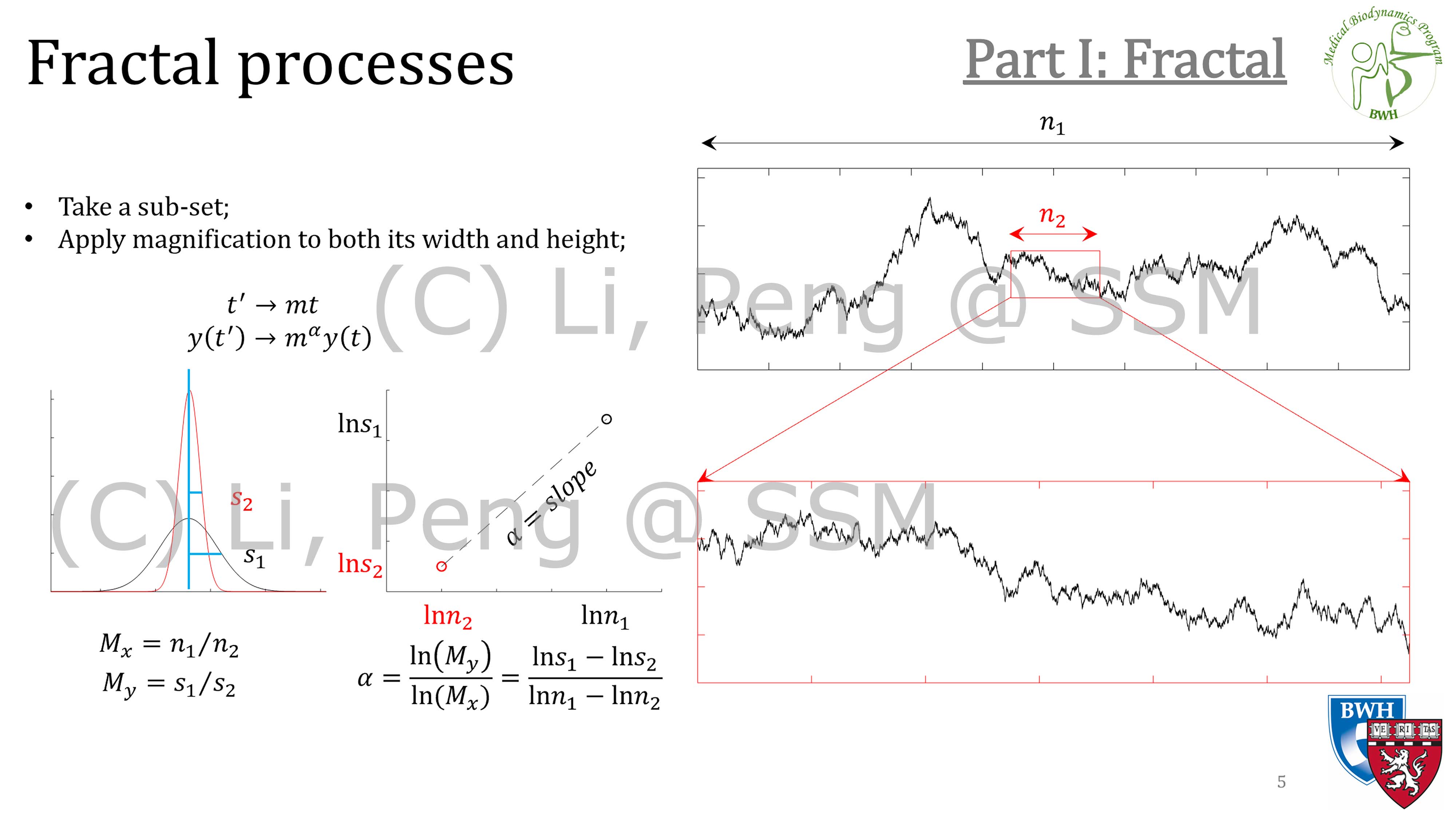
- Date: October 21, 2019
- Event: Society for Neuroscience Conference 2019
- Location: Chicago, IL
I presented a poster at the Society for Neuroscience Conference 2019 in Chicago. This poster is about the relationship between randomness of motor activity fluctuations (or multiscale temporal correlation) and brain pathology. We found that increased randomness was associated with increased burden of certain pathological biomarkers in the brain. More interestingly, increased randomness uniquely explained 10% variance of cognition in addition to multiple brain pathologies. See also our most recent publication in Sci Transl Med (cover feature).
- Date: June 12, 2019
- Event: SLEEP 2019
- Location: San Antonio, TX
An oral presentation discussing the interaction between Alzheimer’s progression and circadian disturbances. The medical media Medscape News covered this presentation with title Circadian Rhythm Disturbances May Be an Alzheimer’s Marker. See also the related article published in The Lancet Healthy Longevity.
- Date: June 10, 2019
- Event: SLEEP 2019
- Location: San Antonio, TX
This is an oral presentation. The results indicate that disturbances in circadian rhythms appears to be a predictor of physical disability and mortality in older adults.
- Date: April 15, 2019
- Event: The 10th Annual Rush Alzheimer's Disease Center ROSMAP Investigator's Meeting
- Location: Chicago, IL
I was invited to give a 15-min oral presentation on our research about fractal motor regulation. I presented new results we obtained resently about the association between fractal motor regulation and future incidence of adverse health outcomes. A manuscript related to these results is currently under review.
- Date: November 05, 2018
- Event: Society for Neuroscience Conference 2018
- Location: San Diego, CA
A poster presentation on my most updated findings on the brain correlates of fractal activity regulation. I was given a Trainee Professional Development Award during the conference.

- Date: June 05, 2018
- Event: SLEEP 2018
- Location: Baltimore, MD
- Poster: Download the poster
A poster presentation explaining the work about fractal activity regulation and its predictability of Alzheimer’s dementia and cognitive decline. Results have been officially published in Alzheimer’s & Dementia: The Journal of the Alzheimer’s Association.
- Date: June 05, 2018
- Event: SLEEP 2018
- Location: Baltimore, MD
A poster presentation on my most recent findings about the brain correlates of fractal activity regulation. In briefly, we identified 15 brain regions/subregions from the structure MRI scans that showed associations with the fractal activity patterns at time scale < 90 min. Linear regression models adjusted for age, sex, and years of education explain on average 20% the variation of the gray matter volumes of these regions. Working on manuscript right now.
- Date: May 30, 2018
- Event: The 9th Annual Rush Alzheimer's Disease Center ROSMAP Investigator's Meeting
- Location: Chicago, IL
An invited 15-min talk focusing on my recent research on the fractal regulation and brain pathology. I briefly reviewed the published paper Fractal activity regulation and incident Alzheimer’s disease in elderly individuals and some of my working papers. Then I talked about many preliminary data regarding the link between fractal regulation and brain pathology.
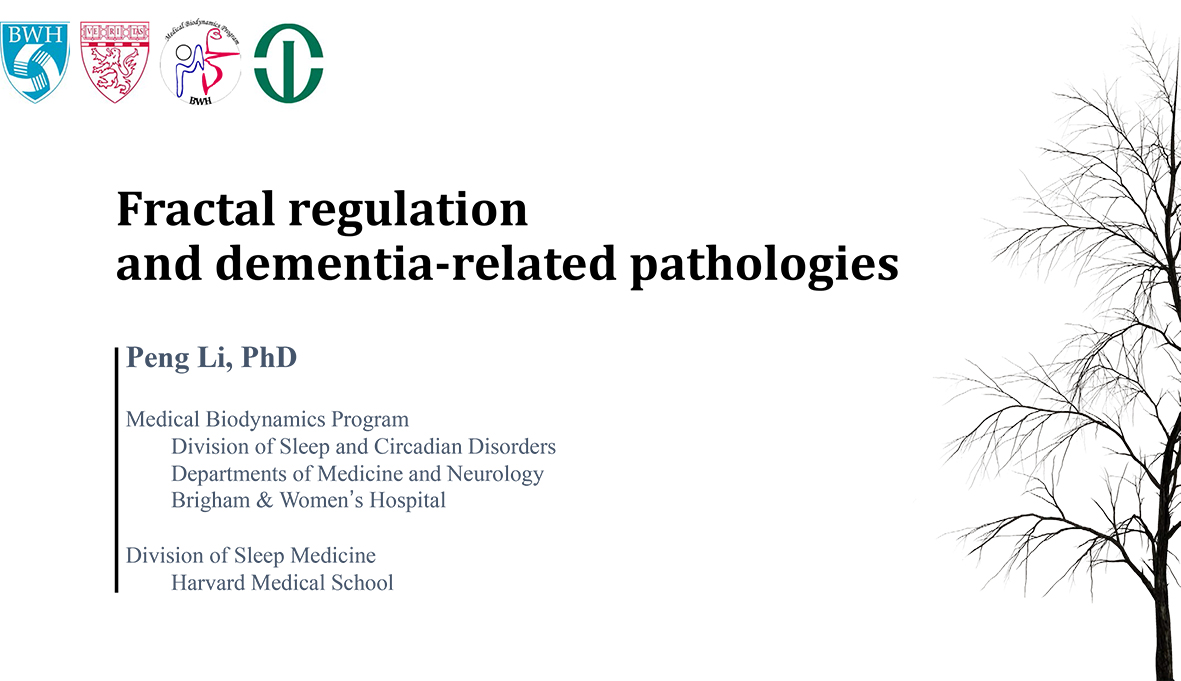
- Date: June 04, 2017
- Event: SLEEP 2017
- Location: Boston, MA
This is a poster presentation focusing on how restricted feeding affects the stability and fragmentation of daily activity rhythms, and how the dorsomedial hypothalamic nucleus mediates these effects.
- Date: June 01, 2017
- Event: SLEEP 2017
- Location: Boston, MA
This is a poster presentation focusing on the aging-induced changes in fractal activity regulation. It was longitudinal, within-subject changes rather than cross sectional correlation.
- Date: May 04, 2017
- Event: The 8th Annual Rush Alzheimer's Disease Center ROSMAP Investigator's Meeting
- Location: Chicago, IL
An invited oral presentation focusing on the preliminary data on altered fractal activity regulation in relation to AD dementia and cognitive decline.
- Date: June 29, 2016
- Event: Boston Mini-Symposium on Circadian Rhythms, Metabolism and Beyond
- Location: Boston, MA
A locally invited oral presentation focusing on how night shift affects the fractal activity regulation in chronic shift workers and non-shift controls.
- Date: May 19, 2016
- Event: The 7th Annual Rush Alzheimer's Disease Center ROSMAP Investigator's Meeting
- Location: Chicago, IL
An invited 15-min talk focusing on how multiscale activity control, or fractal activity regulation, changes with aging process.
- Date: September 08, 2014
- Event: 2014 Computing in Cardiology Conference
- Location: Boston, MA
An oral presentation focusing on a new analysis, namely refined multiscale multivariate fuzzy entropy, and its application to heart rate and diastolic time interval coupling analysis.

- Date: October 31, 2013
- Event: The 46th Haiyou PhD Seminar
- Location: Jinan, China
I was invited to give a talk about my PhD projects to undergraduates and graduates of related majors in my university on my last year of PhD study.

- Date: May 28, 2012
- Event: The 38th World Congress on Medical Physics and Biomedical Engineering
- Location: Beijing, China
I gave an oral presentation regarding my simulation tests on two entropy measures - cross sample entropy and cross fuzzy entropy - that are used for examining the coupling/cross predictability of bivariate time-series.
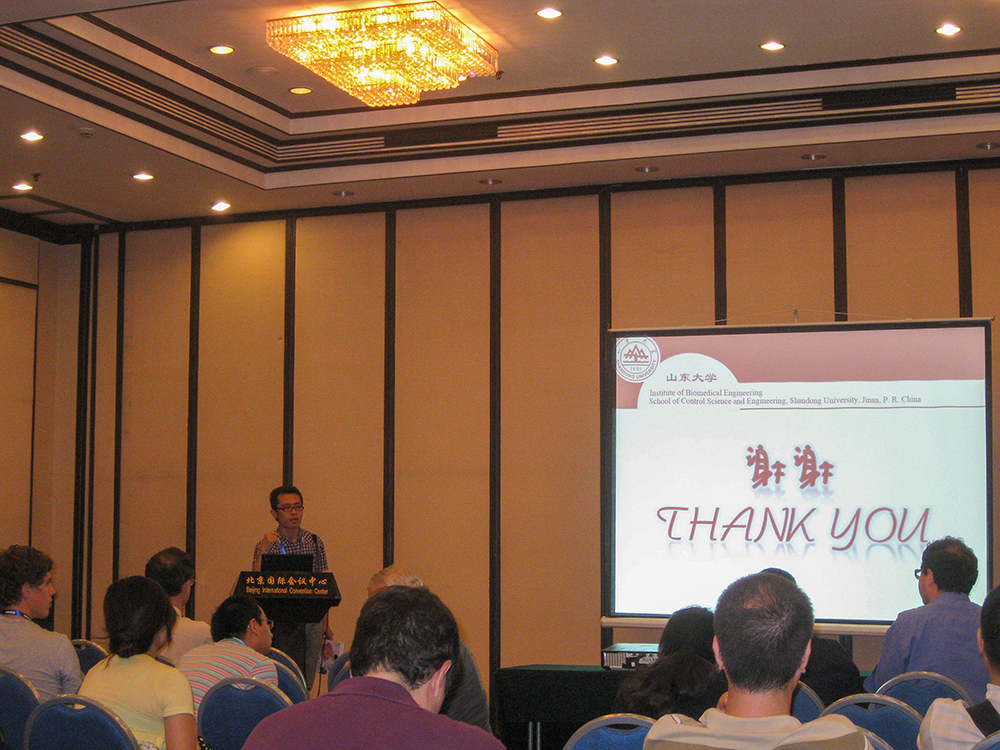
- Date: September 20, 2011
- Event: 2011 Computing in Cardiology Conference
- Location: Hangzhou, China
I gave an oral presentation on a new spectral analysis, namely higher order spectra analysis, on the QT interval variability.
